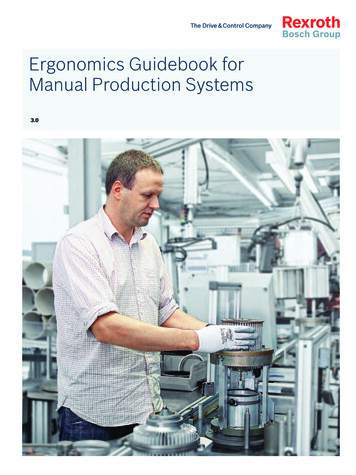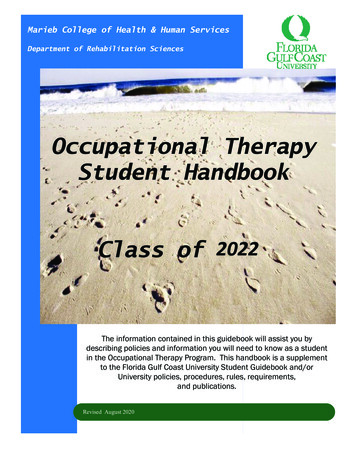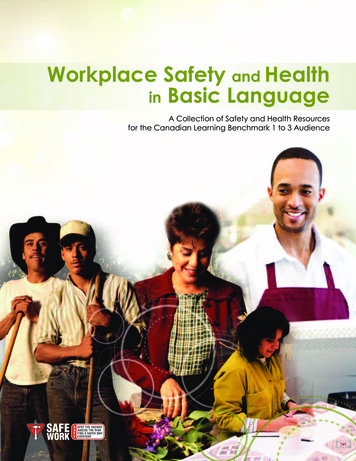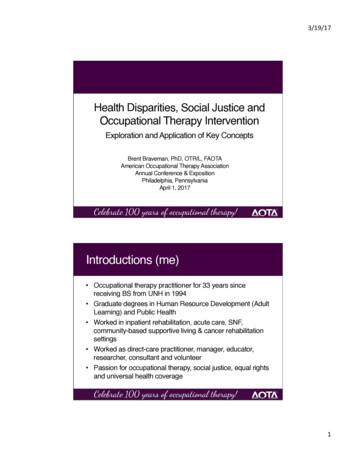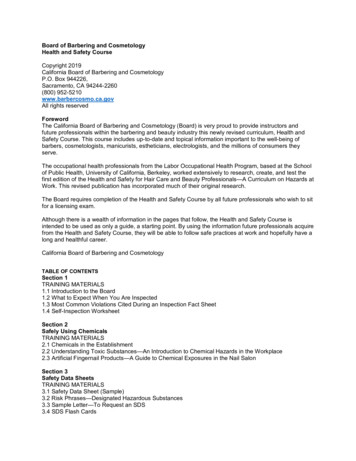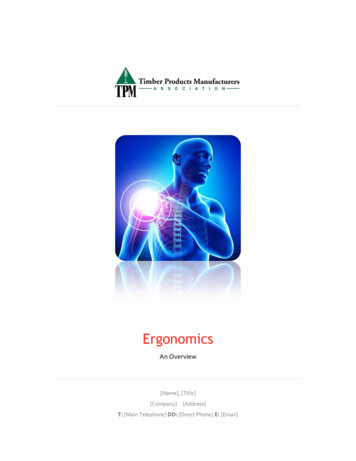
Transcription
ErgonomicsAn Overview[Name], [Title][Company][Address]T: [Main Telephone] DD: [Direct Phone] E: [Email]
Ergonomics 2Ergonomics OverviewErgonomics is the science of fitting the job to the worker. Designing work stations and tools to reduce workrelated musculoskeletal disorders (MSDs) can help workers stay healthy and companies to reduce or eliminatethe high costs associated with MSDs.Who is Covered?There are no specific ergonomics regulations, although OSHA will continue to cite ergonomic injuries under theGeneral Duty Clause of the Occupational Safety and Health Act, Section 5. All employees are covered by OSHAunder this section.Causes of MSDsProlonged exposure to ergonomic risk factors can cause MSDs. Conditions likely to cause MSD problems include: Exerting excessive force.Excessive repetition of movements that can irritate tendons and increase pressure on nerves.Awkward postures, or unsupported positions that stretch physical limits, can compress nerves andirritate tendons.Static postures, or positions that a worker must hold for long periods of time, can restrict blood flow anddamage muscles.Motion, such as increased speed or acceleration when bending and twisting, can increase the amount offorce exerted on the body.Compression, from grasping sharp edges like tool handles, can concentrate force on small areas of thebody, reduce blood flow, nerve transmission and damage tendon sheaths.Inadequate recovery time due to overtime, lack of breaks and failure to vary tasks, leave inadequatetime for tissue healing.MSDs can affect nearly all tissue in the body: nerves, tendons, tendon sheaths and muscles. The most frequentlyaffected areas of the body are arms and the back.Employee TrainingThere are no specific training requirements for ergonomics. However, employees who have been trained toidentify and avoid ergonomic hazards are better able to avoid those hazards, leading to a safer workplace. Toget the most out of an ergonomics program, an employer can train workers on: Common MSDs and their signs and symptoms.The importance of reporting MSDs, and signs and symptoms, as soon as possible.How to report MSDs in the workplace.Risk factors and work activities associated with MSDs hazards.
Ergonomics 3Training Tips Using the employee handout, define ergonomics.Provide employees with information on MSDs and their signs and symptoms.Stress the need for early reporting, and explain the system to report MSDs, signs and symptoms ofMSDs, and MSD hazards.For More Information See:Occupational Safety and Health Act, Section 5. Duties—General Duty Clause
Ergonomics 4Ergonomics Overview HandoutAbout 1.8 million workers report musculoskeletal disorders (MSDs), such as carpal tunnel syndrome, tendinitis andback injuries each year. About 600,000 of those workers need to take time off work because of those injuries.Work-related musculoskeletal disorders (WMSDs) occur when the physical capabilities of the worker do notmatch the physical requirements of the job. Prolonged exposure to ergonomic risk factors can cause damage toa worker’s body and lead to WMSDs.Ergonomics is the science of fitting the job to the worker.Designing work stations and tools to reduce MSDs can helpworkers stay healthy and companies to reduce or eliminatethe high costs associated with MSDs.MSD Risk FactorsWe often think of ergonomic problems being associated withyour computer or mouse, but the fact is there are manyrepetitive motions that can cause MSD conditions.Conditions that are likely to cause MSDs include: ForceRepetitionAwkward PosturesStatic PosturesQuick MotionsCompressed or Contact StressVibrationCold TemperaturesAn awkward and static position can lead to an ergonomic injury.What types of Work are Likely to Cause MSDs? Manual handlingManufacturing and productionHeavy liftingTwisting movementsLong hours of working in awkward positionsHow do I know if I have an MSD? Numbness in your fingers or thighsDifficulty moving your fingersStiff jointsBack painConstantly bending over and holding the awkward position towork can also lead to MSDs.
Ergonomics 5Ergonomics – Overview Sign–Off SheetThe employees of Company Name , have taken part in a training session onErgonomics Overview. The session covered: The definition of work-related musculoskeletal disorders (WMSDs).The signs and symptoms of WMSDs.The importance of early reporting, risk factors, jobs and activities associated with MSDs.DATE OF TRAINING:EMPLOYEE SIGNATUREFACILITY:PRINT NAMESupervisor’s Signature
Ergonomics 6This material was produced under grant SH26336SH4 from the Occupational Safety and Health Administration, U.S.Department of Labor. It does not necessarily reflect the views or policies of the U.S. Department of Labor, nor does mentionof trade names, commercial products, or organizations imply endorsement by the U.S. Government
time for tissue healing. MSDs can affect nearly all tissue in the body: nerves, tendons, tendon sheaths and muscles. The most frequently affected areas of the body are arms and the back. Employee Training There are no specific training requirements for ergonomics. However, employees who have been trained to
